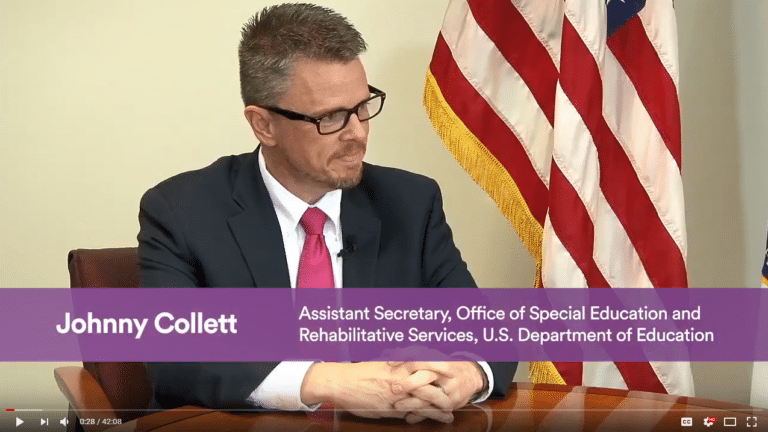As former State Special Education Director in Kentucky, and Program Director, Special Education Outcomes at the Council of Chief State School Officers (CCSSO), Johnny Collett knows a thing or two about leadership. CCSSO worked closely with other members of the National Policy Board for Educational Administration (NPBEA) to develop the 2015 Professional Standards for Educational Leaders (PSEL), a document designed to ensure that all school leaders – whether in preparation programs or current practice – have the skills and abilities they need to help children succeed.
In January 2017, CCSSO released, jointly with the Collaboration for Effective Educator Development, Accountability, and Reform (CEEDAR) Center, PSEL 2015 and Promoting Principal Leadership for the Success of Students with Disabilities. The document is meant to supplement the PSEL 2015 and provide guidance on how the standards can be applied to support inclusive principal leadership in policy and practice and highlights aligned key principal competencies toward meeting those goals.
On April 26th, Johnny, along with CCSSO Senior Program Associate Kaylan Connally; Former NASDE president, Alice Parker, and Former Assistant Secretary of OSERS, Alexa Posny will explore the standards in-depth at ONEder’s “Promoting Leadership in Special Education” conference, in Newark, New Jersey.
Can you tell us a little about your background? Where are you from, and how did you find your way into the field of education?
Prior to coming to CCSSO, I was the state director of special education in Kentucky. I also served as an assistant division director, and before that, an exceptional children consultant at the Kentucky Department of Education (KDE). Prior to working at KDE, I was a high school special education teacher.
How, and why, did you become involved with the CCSSO?
In early 2015, while serving as the state special education director in Kentucky, I became aware of a new position that CCSSO had established to focus on supporting states in their work to improve outcomes for children with disabilities. Having seen the work from various perspectives at both the local and state level, as well has having had the opportunity to engage in national conversations around improving outcomes for children with disabilities, I became increasingly interested in how I might lend my experience to add value to CCSSO’s efforts to support states in this space, and how we might all work together across the country toward collective impact in service to all kids.
Why is academic success for students with disabilities important to you?
The same reason that academic success for any student is important to me. While it is true that much progress has been made over the last 40 years since the passage of the Individuals with Disabilities Education Act (IDEA), it is also true that there is still much work to do to ensure that all children, including students with disabilities, are prepared for success. For example, states have learned that a focus on compliance under IDEA, while necessary, is not sufficient by itself to improve achievement and outcomes for SWD. States are not content to maintain environments where the achievement of compliance alone is viewed as success. As a result, the focus has expanded beyond compliance to include intentional focus around results and to improving achievement and outcomes for SWD, as well as associated staff development and school improvement toward that end.
What is the biggest challenge to the academic success of students with disabilities?
At CCSSO, we are committed to supporting states in their efforts to ensure that all students – regardless of their background – are prepared for success in college, careers, and life. And, we are mindful that for “all to mean all”, it has to mean each. So, as we think about and prioritize our work, the guiding question for us is always, “Is it right for each kid and does it lead to college and career readiness?” There are, of course, a number of challenges to improving outcomes for students with disabilities, some of which are deeply complex and historically rooted. As a result, there are often not simple solutions and needed changes do not happen overnight. However, we are committed to prioritizing equity in our work to support states and to ensure that each child has access to the resources and educational rigor they need, at the right moment in their education, regardless of their circumstances or background.
I will call out one challenge that is particularly on my mind lately, and one about which I often speak. I refer to it as the intersection of high expectations and appropriate supports. Here’s what I mean. I find that we tend to talk about one or the other of those. For example, we may talk about having high expectations for all students, but we may not extend that conversation to the resources and supports that kids need to be successful. Conversely, we may talk about the resources and supports that kids need, but, at the same time, perpetuate a culture of low expectations for those kids. I contend that conversations that focus on either side of this intersection, without the other, are equally wrongheaded. So, as we think about improving academic achievement and outcomes for students with disabilities, we must talk about both high expectations and appropriate supports. That may seem simple, but I would argue that we may not be as intentional around this as we like to think that we are.
Why did the CCSSO release the PSEL 2015 and Promoting Principal Leadership for the Success of Students with Disabilities?
Principals are the second most influential in-school support to students and have the responsibility to create and foster the conditions for teaching and learning that provide them an equitable opportunity to succeed. As a result, ensuring that principals are equipped to meet the needs of every child is critical. CCSSO has a relentless focus on kids and believes in the power of both teachers and leaders to improve student outcomes. While having a highly effective teacher and access to rigorous curriculum is important, students must also have access to highly effective principals who lie at the nexus of high expectations and appropriate supports. Student success means making sure every leader has the preparation, development, and support they need. Building on an existing body work around educator preparation, including Promises to Keep: Transforming Educator Preparation to Better Serve a Diverse Range of Learners, this guidance includes a range of actions states can take to strengthen inclusive principal leadership in both policies and practices related to principal preparation and development.
Why is it so important to have a guidance document to the PSEL 2015 related to students with disabilities?
When principals cultivate an environment where all students feel safe, supported, and included, students with disabilities and other struggling learners thrive. In years past, school leaders primarily focused on complying with various Individualized Education Program (IEP) requirements, laws, and regulations related to educating students with disabilities. That focus has since expanded beyond compliance to one that ensures that students with disabilities are ready for college and careers when they leave high school. While the PSEL 2015 calls out the importance of principals in ensuring the success of each and every child, it also extends to all school leaders—not just principals. It is important to call out the principal’s critical role in supporting equitable learning opportunities for each student and in leading inclusive learning environments that enable them to succeed. The guidance calls out those aspects of the standards that are particularly relevant for principals to effectively support teachers to meet students’ diverse learning needs and highlights key competencies aligned to the standards that principals need to lead inclusive schools.
Who took part in developing this document?
CCSSO and the CEEDAR Center convened the Principal Competencies Advisory Group from January through October 2016 to inform this guidance document. The Advisory Group comprised principals; leaders from state and local departments of education; members of the higher education community; and representatives of professional associations serving educational leaders. These individuals guided the conceptualization, organization, and content of this document after an in-depth review and synthesis of the relevant literature on principal leadership.
How did you find the exemplars included as examples for the standards?
Many of the examples included in the document are those informed by practitioners in the Advisory Group. We felt it was important to provide examples to bring the document to life and help illustrate what inclusive principal leadership “looks like” in practice straight from the practitioners themselves.
What input did you get on the standards from educators, families, or students with disabilities?
CCSSO and CEEDAR shared initial draft guidance at several convenings of SEA leaders and educators. The Advisory Group itself comprised principals or former principals and provided extensive revisions to ensure clarity and maximum impact. An in-depth review and synthesis of literature on principal leadership for serving students with disabilities was integrated into the working group’s recommendations and the final guidance document.
While the document is intended for chief state school officers and state education agency staff, what is the biggest take-away for school leaders?
The standards focused on literature that refers directly to principals rather than special education administrators, special education coordinators, and/or school-level non-administrative special education leaders. This was a deliberate choice because of the principal’s primary role in creating and leading learning environments that foster the success of students with disabilities. The PSEL 2015 standards, on which this guidance document is based, extends to all school leaders—not only to principals. We thought it was important to call out those aspects of the standards that are key for supporting and ensuring principals can meet the needs of diverse learners and foster equitable learning environments where each child can succeed.
What additional resources are available for school leaders and educators?
The CCSSO website has many additional resources available for both teachers and leaders. PSEL 2015 and Promoting Principal Leadership for the Success of Students with Disabilities is part of a suite of guidance documents created to stimulate a more nuanced conversation about school leadership and strengthening the instructional capacity of principals. Along with PSEL 2015, these include 2015 Model Principal Supervisor Standards, and CCSSO’s Our Responsibility, Our Promise and Promises to Keep. The latter two publications outline how states can transform educator preparation so teachers and principals are better equipped to help all students achieve. The suite also includes the forthcoming National Educational Leadership Preparation (NELP) standards from the National Policy Board for Education Administration. These standards align directly with the PSEL 2015 and inform the preparation of aspiring educational leaders and the process by which preparation programs seek accreditation. CCSSO supports and engages member states in the use and application of such resources through membership meetings as well as through various collaboratives and working groups.
How have the standards been received?
Positively. A subset of states has revised leadership standards to align with the PSEL 2015 and are beginning to use the standards for professional learning for principals, evaluation and feedback, and informal coaching. They’re also beginning to apply the standards to their licensure and certification requirements. And many more states have plans to revise their leadership standards to align with PSEL. Now is the time to support states in advancing inclusive principal leadership in policy and practice.
What’s the best anecdote you’ve heard about implementing the standards since they were launched?
We recently hosted a group of aspiring special education leaders for a meeting at CCSSO. The group, comprised mostly of current principals and special education teachers or coordinators, wanted to learn more about our organization, membership, strategic support to states, and federal policy influence. At the meeting, we shared copies of the PSEL 2015 and Promoting Principal Leadership for the Success of Students with Disabilities. A participant shared that she wished this document had informed her principal preparation program—she hadn’t had the opportunity to study or practice all of the skills and competencies included in the document. Luckily, she was a former special education teacher and could extend her knowledge of meeting students’ diverse learning needs based on her former role. But she emphasized how that is rare in the current principal landscape. Many principals are not former special education teachers, and those in her cohort often leveraged her and her knowledge of the supports needed by students with diverse learner profiles. She highlighted how much this document is needed in current principal preparation policy and practice to support all principals to lead inclusive schools.
What’s next for CCSSO?
CCSSO recently held, in collaboration with CEEDAR and the Center on Great Teachers and Leaders (GTL), a convening of national experts focused on principal supports and students with disabilities. Thirty-two individuals representing federally-funded TA centers, national organizations, and CCSSO staff discussed the critical role of principals in supporting teachers and improving outcomes for all students, with a particular focus on students with disabilities. Each organization committed to take their learnings and share them back with their colleagues and made specific commitments for how they will move this work forward within their particular scope of work. To facilitate this ongoing collaboration and ensure we are all communicating a consistent, rather than conflicting, message regarding strengthening support for school leadership, CCSSO is committed to supporting this group in collective work to advance inclusive principal leadership in both policy and practice over the next year.






